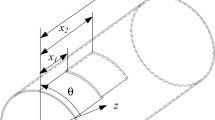Summary
The graphodynamical theory developed in a previous paper is used to treat elastic impact of a cylindrical hammer on a bar with sudden or stepwise increase or reduction of area, with neck or swell or with capblock. The influence of area ratios in these cases and for impact on a cylindrical bar of hammers consisting of two cylindrical parts of different diameters is given in formulae and diagrams. For elastic impact of bars with rounded ends a graphical equivalent to the numerical iteration method of Sears is given and compared with a simpler graphodynamical method. Some examples indicate the influence of impact velocity and radii of curvature on the form of the pulse front. In a number of cases the theoretical results are compared with oscillograms, and fairly good agreement is found.
Similar content being viewed by others
Abbreviations
- A :
-
Cross sectional area
- a, b, c...:
-
Different states (combinations of force and velocity values)
- D :
-
Diameter of bar
- E :
-
Young's modulus
- L :
-
Length
- P :
-
Force
- q :
-
Reflection constant \(q = \frac{{1 - r}}{{1 + r}},{\text{ }}q1 = \frac{{1 - r_1 }}{{1 + r_1 }},{\text{ }}q2 = \frac{{1 - r_2 }}{{1 + r_2 }}\)
- r :
-
Total area ratio r=A 3/A 1 etc. In the general case where different materials are considered r is the ratio of “dynamic stiffnesses” \(r = \frac{{A_3 E_3 /u_3 }}{{A_1 E_1 /u_1 }}etc.\)
- r i :
-
Area ratio between consecutive steps in case of several steps. \(r_1 = \frac{{A_3 }}{{A_2 }} = \frac{{cot \alpha }}{{cot \beta }},{\text{ }}r_2 = \frac{{A_4 }}{{A_3 }} = \frac{{cot \beta }}{{cot \gamma }}etc.\)Total area ratio r=r 1·r 2. ...
- s :
-
Displacement
- t :
-
Time
- T :
-
Duration of elementary pulse T=2L 1/u 1
- u :
-
Velocity of disturbance propagation (of sound)
- v :
-
Particle velocity
- W :
-
Energy
- x :
-
Coordinate along bar
- α, β, γ :
-
Directrix angles with ν-axis in diagram of state
- ρ :
-
Density
- σ :
-
Stress
- τ :
-
Time unit for method of Sears, τ=L 1/u
References
Fischer, H. C., Appl. Sci. Res. A 8 (1959) 105, called I.
De Juhasz, K. J., J. Franklin Inst. 247 (1949) 15.
Fischer, H. C., Appl. Sci. Res. A 4 (1954) 317.
Campbell, J. D., and J. Duby, Roy. Soc. London Proc. A 236 (1956) 24.
Donnell, L. H., Trans Amer. Soc. Mech. Engrs. 52 (1930) 153.
De Saint-Venant, B., Comptes Rendus 66 (1868) 877.
Thornton, L., Engineering 169 (1950) 689.
Dahl, Hjalmar, O., Jernkontorets Annaler 116 (1932) 403.
Hueter, T. F. and R. H. Bolt, Sonics, p. 275, New York 1955.
Fischer, H. C. and G. Holmstrand, unpublished paper, 1954.
Sears, J. E., Trans Cambr. Phil. Soc. 21 (1908–12) 49.
Fanning, R. and W. V. Bassett, J. Appl. Mech. 7 (1940) A 24.
Author information
Authors and Affiliations
Rights and permissions
About this article
Cite this article
Fischer, H.C. On longitudinal impact II. Appl. sci. Res. 8, 278–308 (1959). https://doi.org/10.1007/BF00411755
Received:
Issue Date:
DOI: https://doi.org/10.1007/BF00411755



